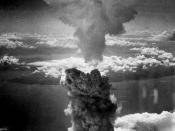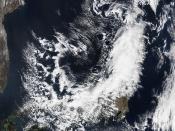Just before the beginning of World War II on August 2, 1939, Albert Einstein wrote a letter to President Franklin D. Roosevelt. Einstein and several other scientists notified Roosevelt of the rising efforts in Nazi Germany to purify Uranium-235, which could be used to build an atomic bomb (Bellis). It was only shortly after when the United States Government began to work on "the Manhattan Engineer District" otherwise known as "the Manhattan Project" (Sherrow).
For the next six years it was up to physicist Dr. Robert J. Oppenheimer and his research crew of the world's top scientists, doctors and researchers "to expedite research to produce a viable atomic bomb" (Bellis). On July 16, 1945, the first successful atomic explosion was carried out near Alamagordo, New Mexico (Bellis). This $2 billion operation (Sherrow), created a new war tactic, known as atomic warfare. Without the development of the A-Bomb and the American warfare strategy to drop them on vital Japanese home islands, World War II would not have ended as abruptly.
Along with the massive reduction of lives that would have been lost if an American invasion in Japan would have resulted.
Away from all the chaos and pressure in producing this A-bomb, global conflict was apparent. World War II was occurring; Harry Truman was faced with an ultimatum, whether to drop the bombs or not. Truman then decided to use the bomb in order to shorten the war and to save an innumerable amount of Allies' lives (Koeller). Japan was given a chance to surrender, but the Japanese did not reply. Therefore, Truman decided to go forth with dropping the bomb on critical Japanese cities.
The first target used to portray the destructive power of the U.S.'s new super bomb was at Hiroshima, an industrial-port city that had a naval...


